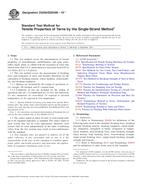We need your consent to use the individual data so that you can see information about your interests, among other things. Click "OK" to give your consent.
ASTM D2256/D2256M-10e1
Standard Test Method for Tensile Properties of Yarns by the Single-Strand Method (Includes all amendments And changes 9/15/2015).
Automatically translated name:
Standard Test Method for Tensile Properties of Yarns by the Single-Strand Method
STANDARD published on 1.6.2010
The information about the standard:
Designation standards: ASTM D2256/D2256M-10e1
Note: WITHDRAWN
Publication date standards: 1.6.2010
SKU: NS-19810
The number of pages: 13
Approximate weight : 39 g (0.09 lbs)
Country: American technical standard
Category: Technical standards ASTM
Annotation of standard text ASTM D2256/D2256M-10e1 :
Keywords:
breaking strength, elongation, yarns, Acceptance criteria/testing--textile fabrics/fibers, Breaking strength/tenacity--textile fabrics/fibers, Elongation--textiles, Force-elongation curves, Secant modulus, Single-strand method, Tensile properties/testing--textile materials/applications, Toughness, Yarn properties, ICS Number Code 59.080.20 (Yarns)
Additional information
| Significance and Use | ||||||||||||||||||||||||
|
Acceptance Testing—Option A1 of Test Method D2256 is considered satisfactory for acceptance testing of commercial shipments because the test method has been used extensively in the trade for acceptance testing. However, this statement is not applicable to knot and loop breaking force tests, tests on wet specimens, tests on oven-dried specimens, or tests on specimens exposed to low or high temperatures and should be used with caution for acceptance testing because factual information on between-laboratory precision and bias is not available. If there are differences of practical significance between reported test results for two laboratories (or more), comparative tests should be performed to determine if there is a statistical bias between them, using competent statistical assistance. As a minimum, use the samples for such a comparative tests that are as homogeneous as possible, drawn from the same lot of material as the samples that resulted in disparate results during initial testing and randomly assigned in equal numbers to each laboratory. The test results from the laboratories involved should be compared using a statistical test for unpaired data, a probability level chosen prior to the testing series. If a bias is found, either its cause must be found and corrected, or future test results for that material must be adjusted in consideration of the known bias. Fundamental Properties—The breaking tenacity, calculated from the breaking force and the linear density, and the elongation are fundamental properties that are widely used to establish limitations on yarn processing or conversion and on their end-use applications. Initial modulus is a measure of the resistance of the yarn to extension at forces below the yield point. The chord modulus is used to estimate the resistance to imposed strain. The breaking toughness is a measure of the work necessary to break the yarn. |
||||||||||||||||||||||||
| 1. Scope | ||||||||||||||||||||||||
|
1.1 This test method covers the determination of tensile properties of monofilament, multifilament, and spun yarns, either single, plied, or cabled with the exception of yarns that stretch more than 5.0 % when tension is increased from 0.05 to 1.0 cN/tex [0.5 to 1.0 gf/tex]. 1.2 This test method covers the measurement of breaking force and elongation of yarns and includes directions for the calculation of breaking tenacity, initial modulus, chord modulus, and breaking toughness. 1.2.1 Options are included for the testing of specimens in: (A) straight, (B) knotted, and (C) looped form. 1.2.2 Conditions of test are included for the testing of specimens that are: (1) conditioned air, (2) wet, not immersed, (3) wet, immersed, (4) oven-dried, (5) exposed to elevated temperature, or (6) exposed to low temperature. Note 1—Special methods for testing yarns made from specific fibers; namely, glass, flax, hemp, ramie, and kraft paper and for specific products; namely, tire cords and rope, have been published: Test Methods D885, and Specification D578. Note 2—For directions covering the determination of breaking force of yarn by the skein method refer to Test Method D1578. 1.3 The values stated in either SI units or inch-pound units are to be regarded separately as standard. The values stated in each system may not be exact equivalents; therefore, each system shall be used independently of the other. Combining values from the two systems may result in non-conformance with the standard. 1.4 This standard does not purport to address all of the safety concerns, if any, associated with its use. It is the responsibility of the user of this standard to establish appropriate safety and health practices and determine the applicability of regulatory limitations prior to use. |
||||||||||||||||||||||||
| 2. Referenced Documents | ||||||||||||||||||||||||
|
We recommend:
Technical standards updating
Do you want to make sure you use only the valid technical standards?
We can offer you a solution which will provide you a monthly overview concerning the updating of standards which you use.
Would you like to know more? Look at this page.




 Cookies
Cookies
